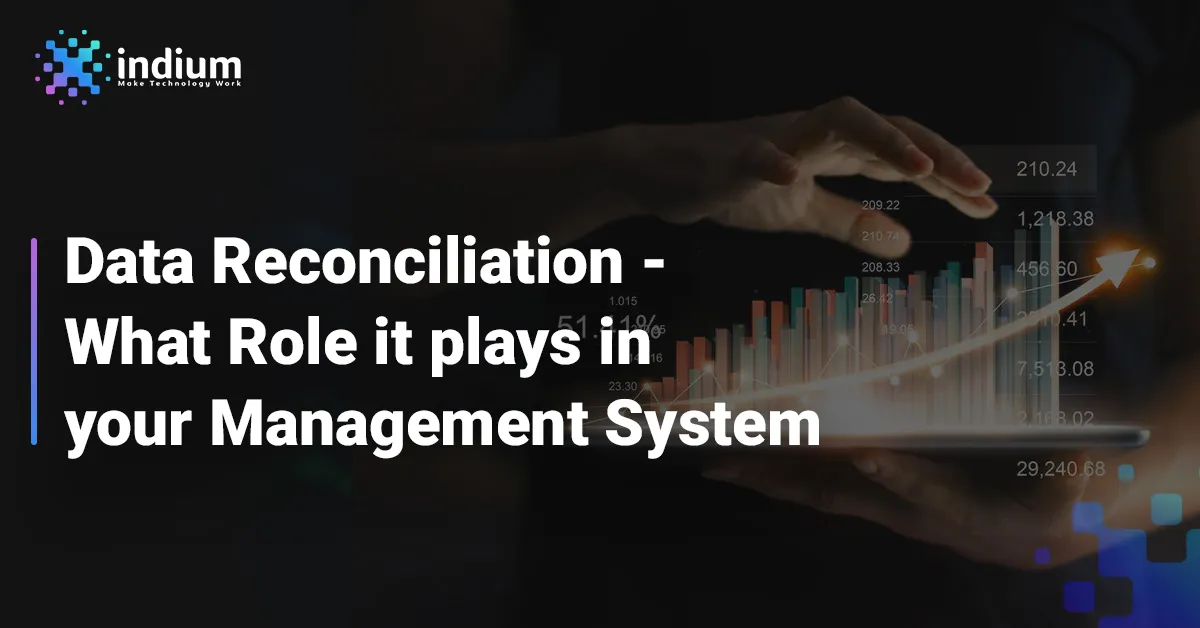Data Reconciliation- What Role it plays in your Management System
Blog: Indium Software - Big Data
What is Data Reconciliation?
During the process of integrating, data begins with the first step of replicating it from different sources before merging and transforming into a format that is usable in the destination system. In order to verify that the target data is the same as it is in the source database, data reconciliation is done to verify whether the target data is from the source data.
Why is Data Reconciliation important?
Data Verification is Important
It helps to make sure that there is no missing data. There is a need to have high quality and fully finished data to have better analytics and data insights. With the wrong data entries, there will be inaccurate insights which in turn ultimately becomes a setback to the data management task.
Record Counting Method
There is a need to make sure that one’s data is verified and that there is no other kind of network or infrastructure issue that has prevented the data from being extracted, loaded or transformed into the target. Record counting helps to keep track of the updates to the data managementt system so as to make sure that it is secure.
Maintaining Fullness of Data
It helps to make a singular and a uniform set of consistent data that represents the most probably processes. Data reconciliation has to be done at the most minute row and column levels, and for the most salient columns have multiple data sources. This means that there is huge load that is put on the source system to migrate the data and it also additionally requires more engineering work, which are both expensive affairs in their own respects.
Cutting edge Big Data Engineering Services at your Finger Tips
Benefits of Data Reconciliation
- Data reconciliation makes sure that data is not misplaced in the migration process and assures that there are accurate results for management tasks.
- Recording updates in the management system is paramount for ensuring a proper secure ecosystem for information to be stored.
- Duplicate records are automatically eradicated if necessary and badly formatted values can be highlighted to improve overall accuracy of the data.
- Having actionable insights is made easy through the efficiency of extracting reliable information from raw measurement data with data reconciliation.
Types of Data Reconciliation
Transactional Data Reconciliation
This kind of data reconciliation process is used in terms of the total amount of data at one’s disclosure; which makes sure that there is no mismatching triggered by the multi-dimensionality of the qualifying attributes of data. These kind of transactional data in migration are the base of business intelligence reports. Hence, if there does arise any mismatch in the transactional data, it impacts on the reliability of the report and the whole business intelligence structure as a whole.
Master Data Reconciliation
This method is used to reconcile when the master (main) data between the source and the target. This kind of data is usually constant and slowly changing in nature and no classifying or accumulation tasks are performed on the data set available. There is a need to make sure that transactions in these activities are secure and valid in purpose. This is done by making sure that the said transactions have been properly authorized by the right systems.
Automated Data Reconciliation
In big data warehouses, it is very easy to automate the whole process of data reconciliation by making the reconciliation the fundamental part of data loading. This process lets one to maintain separate loading metadata tables. This kind of reconciliation also makes sure that all the stakeholders are informed of the validity of the reports so as to have an effective feedback system with all parties involved.
Tools for Data Reconciliation
When looking for data reconciliation tools, one needs to make sure that the reporting of the system is accurate; that it can manage an issue when it arises automatically, makes transaction matching from the target data to the source data easy and to be able to classify records to their attributed classes.
Leverge your Biggest Asset Data
Leverge your Biggest Asset Data
Some of the best reconciliation tools are as follows:
OpenRefine: Previously called Google Refine, it is a powerful tool to work with unorganized data. It cleans it and transforms it from one format to another, expanding its horizons to web services and external data.
TIBCO Clarity: TIBCO Clarity provides a interactive data cleansing solution that also helps to visualize and transform data to your scalable needs. Raw data can be gathered and visualized as trends and outliers in order to classify data sets more meticulously. Validation of data and further cleansing transforming of data is done to remove replicas etc.
Blackline: This is a close software application that helps in maintaining continuous improvements on one’s business. It includes cloud financial systems, process management systems, reconciliation and account automations. Blackline has capabilities to hold a huge amount of data and to be able to deal with a variety of formats of information.
The post Data Reconciliation- What Role it plays in your Management System appeared first on Indium Software.
